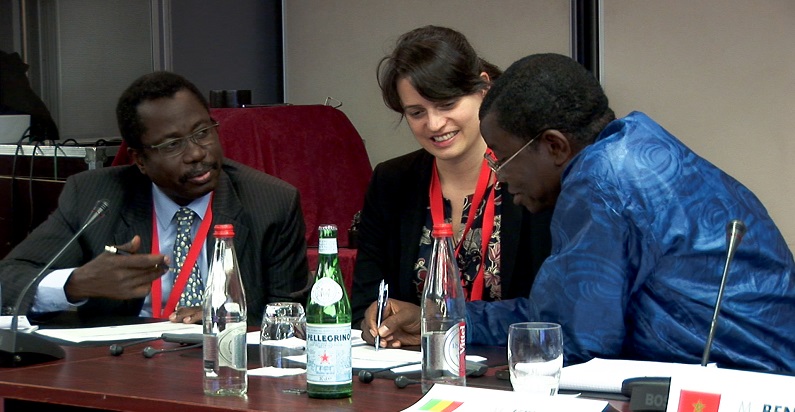-
12 March 2015
Category : Interview
”The Migration and Development programme was created in response to the Crisis of the Cayucos”
Entrevista a Sara Bayés, jefa del Programa de Migración y Desarrollo de la FIIAPP desde hace más de seis años, y actual responsable del equipo de Administración Pública y Asuntos Sociales. De su mano, hacemos repaso del pasado, presente y futuro de este programa.Interview with Sara Bayés, head of the FIIAPP's Migration and Development Programme for the past six months and current leader of the Public Administration and Social Affairs team. She takes us on a tour of the past, present and future of this programme. Interview with Sara Bayés, head of the FIIAPP's Migration and Development Programme for the past six months and current leader of the Public Administration and Social Affairs team. She takes us on a tour of the past, present and future of this programme. Interview with Sara Bayés, head of the FIIAPP's Migration and Development Programme for the past six months and current leader of the Public Administration and Social Affairs team. She takes us on a tour of the past, present and future of this programme.

How did the FIIAPP start to manage migration projects?
The FIIAPP started working on migration issues in2006. The Migration and Development programme was created due to the so-called ‘Crisis of the cayucos’, which arose in 2004-2005 with the arrival of Sub-Saharan Africans to the Canary Islands in an irregular situation, and to the importance of understanding this issue not as an issue limited to border management but also one of understanding the reasons why these citizens are leaving andrisking their lives. And it was started for the purpose of collaborating with the government agencies that work on migration issues through the implementation of international cooperation projects. It continues to be an important issue today on Spanish and European foreign action agendas.
And what do these types of cooperation projects consist of?
It’s institutional cooperation that does not address the specific details of supporting legislative reform, for example, in Morocco but rather one that presents practices in issues of remittances and development, practices in integration issues and practices in the labour market, as well as return and reintegration policies. What has worked in one country, why it worked and how it can be replicated.
In what regions does the FIIAPP work?
In West Africa, Mediterranean countries and Latin America and the Caribbean. In the latter, we are working on building public policies, policies for governability, good governance of migratory flows; in West African and Mediterranean countries, we accompany policy dialogues.
How many projects is it currently managing?
There are three: the policy dialogue of the Rabat Process, the dialogue that accompanies the debate with Latin America and the Caribbean on Migration and Development, and the EUROMED Migration III project, which facilitates experience exchanges between the countries of the southern neighbourhood: Mediterranean, Maghreb and Mashrek, and the countries of the European Union.
Are these processes the countries themselves request?
Yes. They arise out of the interest of the countries that we refer to as the countries of origin for migratory flows. In fact, the Rabat Process grew out of the first conference which was held in July 2006 in Rabat between transit, origin and destination countries for migratory movements.
And how does the FIIAPP work with them?
It provides the experience or know-how of Spanish and European governments. It highlights what has worked in European experiences so that it can be replicated in third countries. We facilitate conferences, experience exchanges; we identify experts and best practices; we conduct studies, capacity diagnoses and needs analyses, for example of the job market in Mexico or the Dominican Republic: to what extent those countries, which are now receiving population, have to take into account that migration policy is not a security policy but instead one linked to the job market, and how the population living abroad can be encouraged to return and be a potential source of development for the country of origin.
Do some of these projects work with the migrant?
Yes, indirectly. The policy addresses people and people’s lives, and so there is always a focus that thinks about how to improve this law and who it will impact. In the Latin American and Caribbean project, there is considerable work in the area of financial education, on the use of savings for investment in productive projects. We work with and through interested Latin America and Caribbean countries, with the governments, to construct partnerships between government, the private sector and the migrants and their families.
Do the funds for these projects come from the European Union?
Yes, the European Commission, since 2005, has had a very clear focus on the external aspect of migration, understanding that migration is not just an issue of integration of new citizens but how and at which moments migratory flows towards Europe are generated. Already by 2011 the second global approach to migration and development had been approved, which emphasized the importance of also using an approach that promotes legal migration, combats illegal migration, boosts the positive impact of migration on development in the origin and destination countries, and all of these follow the component of international protection.
Is the European Commission going to continue focusing on migration?
Yes, for the European Commission, in the programming for 2014-2020 the migration issue is a priority, in both integration and security policies and development policies.
The author has sole responsibility for the opinions and comments expressed in this blog
The views and opinions expressed in this blog are the sole responsibility of the person who write them.






